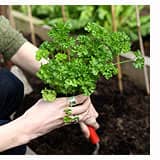Food Tips
Invasion of the herbs : 10 great ways to use up your herb harvest

Food Tips
Invasion of the herbs : 10 great ways to use up your herb harvest
Before you even think about turning them over as compost, peruse these clever tips. Chefs across Canada with their own kitchen gardens have this same problem year after year and have devised all kinds of imaginative ways to use up their delicious bounty.
Branch Out
“Branches of woody herbs such as rosemary can be used as garnishes in mixed drinks,” advises Sinclair Philip of Victoria’s Sooke Harbour House. While rosemary makes a great swizzle stick, delicate herbs like mint, coriander and lemon balm can also add zip to your summer cocktails.
Top photo: Oregano patch overlooking Trinity Bay near Fishers' Loft Inn, N.L.
 Up in Smoke
Up in Smoke
Philip also recommends reserving a few of those sturdy rosemary branches to use as skewers for grilled kabobs. Fragrant thyme, sage or rosemary can also add flavour to barbecued food just by tossing a few dampened bunches of them directly on hot coals. The oils mingle with the smoke imparting an unusual smoky-herbal essence to whatever you’re grilling.
Photo: 




 Honeydew Melon Sage from Sooke Harbour House, B.C.
Honeydew Melon Sage from Sooke Harbour House, B.C.
 Vaporize ‘Em!
Vaporize ‘Em!
Chef Paul Rogalski of Calgary’s Rouge has his own unique ideas for abundant herbs: “In the productive months we steam fish or seafood on the leaves; or even put herbs into the steaming water. We also do fun things like make aromatic water and atomize them at the table to perfume the air.”
Photo:
 Picking herbs at Rouge, Calgary, Alta.
Picking herbs at Rouge, Calgary, Alta.



 Just Sip It!
Just Sip It!
Next time you crave a cup of herbal tea, don’t search the cupboard for a stale teabag. Instead, peruse your garden for the most aromatic herbs you can find and steep them until you have a fragrant, fresh infusion. “I always have lemon verbena in my personal garden,” says Jean-Pierre Curtat (executive chef at Nuances in Montréal) who enjoys an herbal tea at the end of his workday. “It makes a great tea that can be mixed with other herbs or flowers.”
Photo: Shingeku, or Japanese Chrysanthemum at Sooke Harbour House, B.C.
 Surprising Sweets
Surprising Sweets
Although herbs usually conjure up savory thoughts, they also lend themselves beautifully to sweet preparations. Sinclair Philip points out that “herbs are excellent in many sorbets,” and his colleagues agree, recommending basil, lavender, rose, and edible flowers such as scented geranium as “excellent flavourings for all kinds of desserts.” Peggy Fisher (Innkeeper of Newfoundland’s Fisher’s Loft Inn) says that besides sauces and sorbets, simple baked goods can also benefit from the addition of herbs. A popular treat at her inn, for example, are the blueberry-sage corn muffins. Why not try adding a few chopped herbs to your own favorite fruit-muffin recipe?
Photo: Sorting late flowering lavender at Sooke Harbour House, B.C.
 The Big Freeze
The Big Freeze
Most chefs advise freezing as the simplest method of dealing with extra herbs. Peggy Fisher describes her technique: “We make basil balls by chopping up basil and combining it with just enough olive oil to form a ball. We then freeze them on a cookie sheet and the next day bag them and store them in the freezer. They’re great in sauces! We do the same with cilantro. Very handy when you live in the country where fresh herbs are not available in the off-season.”
Photo: Coriander and calendula at Fishers' Loft Inn, N.L.
 Signed and Sealed
Signed and Sealed
Remi Cousyn, of Calories in Saskatoon, is also a hands-on herb gardener who believes in preserving as much of his bounty as possible. Besides freezing them, he also likes to put up his herbal concoctions the old-fashioned way. “For example, with tarragon we make a Béarnaise reduction (using cracked pepper, tarragon, shallots and vinegar) and seal it in small jars. It keeps very well that way.”
Photo: Remy Cousyn of Calories, Sask.
 Salad Sunshine
Salad Sunshine
Chef Curtat suggests creating your own flavoured vinegars. Start by “buying some good quality vinegars: red or white wine, or cider—not balsamic.” Then create several varieties of vinegars by using different herbs. “Make sure the herbs are always covered by liquid and let it rest for a couple of weeks.” He guarantees your homemade concoctions will be “like a little sunshine in your salads!”
Photo:  Late summer calendula and borage at Sooke Harbour House, B.C.
Late summer calendula and borage at Sooke Harbour House, B.C.
 Canada Dries
Canada Dries
Chef Rogalski says that at Rouges “one of our most important devices in managing our harvest is a food dehydrator. After the herbs are dry we use a coffee grinder and turn them into powder.” This is also great idea for the home cook—if you don’t own a dehydrator, you can get similar results in your oven set on low heat.
 Move Over Maple!
Move Over Maple!
At Rouges they also use their herbs to “make jellies, purees, oils, and… syrups!” If you’d like to drizzle something unusual on your next culinary creation, try herbal syrup. Just combine sugar and water in a saucepan and heat until the sugar dissolves. Take it off the heat and add chopped mint, basil, or tarragon. Allow it to cool, strain through a fine sieve, and discard the leaves.
Photo: Late summer herb garden by the ocean at Sooke Harbour House, B.C.
Read more:
• Test Kitchen Videos: A chef's guide to cooking with herbs
• French-style potato salad with herbs
• Baked salmon with spring herbs














Comments